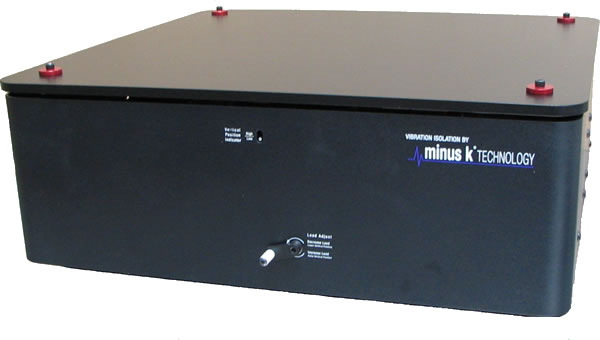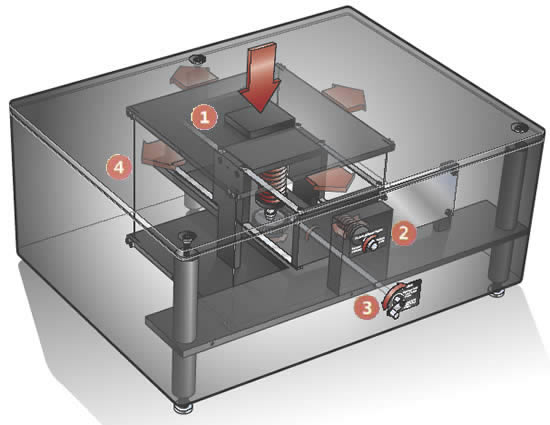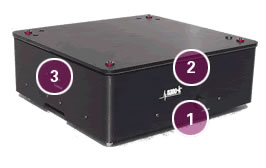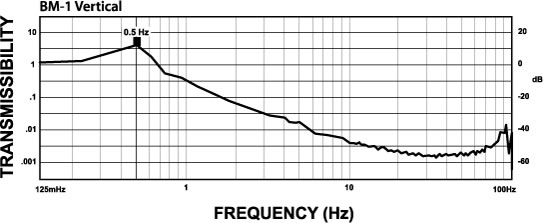
dagogo - May 2013
Audio Accessories
Minus K 100BM-1 Vibration Isolation Platform Review
By: Philip Holmes

How do you describe something that isn’t there? How to you qualify and quantify an absence? With a subjective audio review, lacking a scientific test procedure, describing my impressions will only offer limited benefit to the prospective buyer. In the case of isolation devices, the more energy that is pumped into the system, the greater will be the effect. Poorly constructed rooms with poor acoustical properties will show a greater effect. With no signal, an isolation device has no effect, gradually coming into play as the signal levels rise. This is totally unlike power conditioners and special cables that are able to isolate the raw power, and hence the lowest level signals. Those devices, such as power conditioners, special cables, shielding products, have greater effect as the signal level decreases. The low level information is destroyed due to EMI/RFI and noise on the AC power lines. As AC levels increase, at the source, and also as you increase the volume, acoustical feedback becomes a bigger issue. At the worst, you can have cables and equipment that are both susceptible to EMI and RFI, while also being microphonic. In the end, a system full of equipment and cables like that wastes oodles of power reproducing distortion, acoustic feedback and noise that has nothing to do with the music.
A few products combat both electrical and acoustical noise: Purist Audio Design cables come to mind, as they do a magnificent job of addressing both issues. Certain capacitors are wound and packed in a way that they are shielded electrically and are critically damped. However, there will always be components that lack adequate isolation from the environment, meaning almost every piece of audio ever created. After you’ve addressed cables, AC power and even acoustical properties with room tuning devices, you still have big boxes that resonate, and big speakers that put tremendous energy into the room where these big boxes reside. Some manufacturers attempt to isolate the equipment from vibration, though not very successfully, and most don’t even try. That’s where isolation platforms come into play.
Until I used the Minus K product, my experience with “isolation platforms” were either the snake-oil variety where sharp pointy feet and thick acrylic magically make vibration disappear, with DIY racquetball devices, which work okay, or with the more ambitious air diaphragm isolation bases from Vibraplane.
Technology and Choices
The Minus K 100BM-1 weighs around 80 lbs, and is quite large at 24” x 23” x 9”. Moving it around is a bit challenging due to the combination of weight and size. I recommend you seek assistance when unpacking and moving. There are four red “shipping collars” that secure the top and prevent damage during shipment. They are held in place with allen head cap screws.
I find it difficult to describe the internal mechanisms of the Minus K isolation platforms. If you refer to the diagram and descriptions below, it says “vertical vibrations are isolated by the spring’s interaction with four pairs of flexures. The weight of the instrument compresses the pre-loaded spring, floating the isolator and aligning the flexures”. Without tearing it apart, I get the “feeling” that it acts like a combination of preloaded coil and leaf springs.
The resonance frequency in the vertical plane is .5 Hz, or less, and is achieved over the weight range of 60-100 lbs, while resonance frequency is load-dependent in the horizontal plane. This differing compliance reminds me of the Decca stereo cartridges. Optimal performance occurs when the platform is loaded with the “nominal” weight. So, if you have an amp that weighs 85 pounds, you will want to add an additional 15 pounds of ballast for best performance.
I found the main disadvantage of the Minus K, in contrast to the Vibraplane, is load leveling. The adjustable feet can be used to level the table, but I felt that it slightly compromised the performance. In my experience, you will get better performance by adjusting the position of the load, and ballast, to level the top plate. With some tube amps, this is a major PITA. I was able to use the BM-1 with the Raven integrated amp, but only with the front of the unit well forward; I had to get the output transformers and power transformer, located at the rear of the amp’s chassis, as close to the middle of the platform as possible. Think of it like this: Cars with 50/50 weight distribution perform better than cars that are nose-heavy. Perhaps I am mistaken, but I believe the Minus K performs best when you center the load and avoid any other “tricks” to level the table..
Once properly adjusted, the Minus K proved markedly superior to every other type of isolation device I’ve used or investigated. The load felt like it was held in suspension by a spherically shaped magnetic field. Regardless of the direction of deflection, the unit maintained its .5 Hz resonance. The various cables attached to the amp affected the performance. Further adventures in cable stiffness, as well as various isolation devices made specifically for cables, could bring further improvements in isolation. The price of the 100BM-1 is $4,150, and there are weight options up to 1,050 pounds in the BM-1 line, costing $6,580. An “automatic” version of the BM-1 series is available in the BA-1 series. The BM-8 series offers similar performance to the BM-1 series, but in much more compact dimensions, and would be appropriate for many source components. There is a wide range of products at the Minus K website. I wouldn’t be surprised if they were able to design a system to isolate an entire listening room.

| 1 – Vertical vibrations are isolated by the spring’s interaction with four pairs of flexures. The weight of the instrument compresses the pre-loaded spring, floating the isolator and aligning the flexures. | 2 – A squeeze force from another spring, controlled by the knob O. is applied to the outside of the flexures via a screw. The “squeezed” flexures constitute a “negative stiffness mechanism” (NSM) that acts like the negative of a spring, reducing the stiffness of the system. | |
| 3 – Four beam-columns connecting an upper and lower column plate act as a horizontal spring to isolate the horizontal motion. The beam-columns are vertically very stiff, but bend slightly in response to horizontal vibration. The weight on the deflected beam-columns reduces the stiffness of the spring, making the system behave like a spring with an NSM. | 4 – The crank moves the base of the spring up and down to compensate for changes in the weight of the payload and to keep the flexures in their straight aligned position. If you increase the weight on the spring (by swapping a lighter microscope for a heavier one, for example), its base must be raised by turning the crank clockwise. |

- Vertical Load Adjustment Crank
Simple manual adjustment compensates for changes in vertical load. - Vertical Load Adjustment Indicator
Easily determine optimum setting using this simple visual indicator. - Vertical Stiffness Adjustment Screw
Dial in Guaranteed 1/2 Hz or less Vertical natural frequency using this simple adjustment.
The curve below shows the typical vertical 1/2 Hz performance of the BM-1. It offers 10-100 times better performance than typical high-performance air tables.—Minus K

It’s Touchy
Like setting the bias in a tube amp with a bunch of parallel pentodes, it takes a while to get the Minus K tweaked to perfection. I had intended to use one of my turntables. Both tables are heavy, weighing from 55 to 70 pounds, but that wasn’t quite enough for the platform I asked for, namely the 100BM-1. I tried using the ballast I had at hand, but the two turntables were hard to balance. Rather than spend dollars buying ballast, and many days precisely balancing the setup, just to tear it down, it was decided that a tube amp would make a good test subject. All vacuum tube pieces are prone to ringing and microphonics, and the Raven Audio Reflection integrated amp that was here for review had a phalanx of tubes, fourteen total, I believe.
The Raven wasn’t overly sensitive to ringing, but it could be easily excited by thumping and tapping. Even here, I ran into the problem of cords. This is such a finely balanced device that a stiff cable will “wag the dog.” My overly stiff speaker cables, and ridiculously stiff power cable required lots of changes in positioning—I would move the amp, move the cables and move the isolation base. Then I would do it again. Then I would do it a few more times. After much moving and adjusting, the Minus K was centered front to back, side to side and top to bottom. In a way, it reminded me of setting up classic spring suspension turntables, like the LP12, AR XA, etc.. The reason people have migrated away from those classic designs has more to do with the difficulty of setting them up properly than performance issue.
For instance, when you changed the tonearm on a spring suspended turntable, it would change the center of gravity, the flatness of the setup, and the resonance frequency of that corner of the turntable. In an ideal world, those spring-suspended turntables would be designed to work with a particular mass of tonearm, and provisions would be to add/remove lead shot from the armboard to keep the turntable level, and with a unified resonance frequency. So, the Minus K reminds me of those finicky designs, though it is even more sensitive to small adjustments because the range of motion is not as “progressive” as with springs, which gets progressively more difficult to deflect as you pushed/pulled from the resting place of the spring. This one feels more like you are in a liquid or magnetic field, and you can move freely until you hit the travel limits.
It’s much easier to make an overkill solid plinth. It also reminds me of what F1 teams goes through to tune a new car. They spend many hours running a course, checking telemetry, making adjustments, and then they do it again, sometimes for weeks. If you really care about your audio, you’ll spend weeks getting it right.
The Minus K doesn’t have a sound. When properly adjusted, the Minus K removes the smear that decreases image depth and width, obliterates low-level signals, robs dynamic power and creates listener fatigue. With most systems, listening at high levels is the same as out-of-control listening. With the Minus K, there is greater musical intensity, without the frenetic qualities of an out-of-control system. Very demanding orchestral recordings, like the Bernstein-Chicago live recording of Shostakovich’s “Leningrad Symphony,” don’t scream as much as they usually do. That particular recording is far from great, but can sound horrible on some equipment. The low brass tone and bite were much clearer. Double bass and cello lines were both easier to follow, while having a truer harmonic signature. Without the Minus K, you can hear the microphonic tubes modulate the signal from acoustic feedback, creating a peculiar flavor of intermodulation distortion. That’s the best way I can describe what the Minus K achieves: lower IM distortion. It mostly isolates the electronics from the acoustics, lowering distortion that behaves very much like intermodulation distortion.
Due to the materials, mass, and the large dimensions of the 100BM-1, the “skirt/apron” could be made to ring. The skirt is isolated from the load, but there is the possibility that it could ring, creating a source of noise. With the smaller units offered by Minus K, I don’t foresee as much of an issue. There are several steps that could be taken to eliminate the ringing, and all could be hidden from the listener.
Another issue for some potential buyers will be the pedestrian looks. It’s not ugly, but it’s not attractive. It reminds me of the VPI 16.5 record cleaner. It just is. It exists to perform its duties. It’s not a problem for me, but it will be for some who value aesthetics as much as sound.
Bass impact and depth were other areas markedly improved. After being freed from the acoustical echo, which is significantly slower in arriving than the speedy electrical signal, the leading edge of midrange and bass transients were cleaner. I heard no tube ringing the way I often do when hitting “pause” or “mute” in the middle of a loud passage. It’s an easy test: Play very noisy music, crank it up, and then hit pause. Do you hear any ringing, like a wine glass? If so, then you have a problem. I have always used tube damping rings, but they have only been partially successful. With the Minus K I still heard a benefit with damping rings, and more than usual. The damping rings push the resonance frequency lower, which allows the Minus K to be more effective.
For What Purpose?
I originally intended an analog application, but wound up testing tubes. Both operations need help. I can see a system that employs several Minus Ks for turntables, tape decks, other source components, preamps and amps, interconnected with carefully chosen cables. In my experience, everything is affected by vibration. The only application that doesn’t make sense is for the speakers themselves. Speakers need to be affixed firmly to the floor for best resolution. Without isolation devices, the only way to take vibration out of the equation is moving sources and electronics to the other side of a massively built wall. I’ve heard one system with a similar approach, and it makes an amazing difference. On the other hand, the majority will either want to see their expensive components, won’t have enough space to sacrifice, or won’t have the money for such a radical step. I don’t know if five or six of the Minus K platforms will be cheaper than redesigning, and rebuilding your listening room, but they are the next best solution.
In the Minus K isolation platforms, I believe audiophiles have a thoroughly designed instrument with a reasonable price. While others will be easier to set up and use, the Minus K will do a better job. If it weren’t for the monumental hassle of constantly changing components, and the demands of reviewing, the Minus K would’ve been a no-brainer purchase. If you are happy with your components, and want to take your system to the next level of performance, you should give these isolation platforms an audition. You’ll be surprised by what you don’t hear.